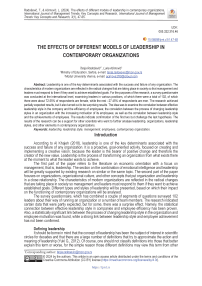The effects of different models of leadership in contemporary organizations
Автор: Tanja Radošević, Luka Aćimović
Журнал: International Journal of Management Trends: Key Concepts and Research @journal-ijmt
Статья в выпуске: 1 vol.3, 2024 года.
Бесплатный доступ
Leadership is one of the key determinants associated with the success and failure of any organization. The characteristics of modern organizations are reflected in the radical changes that are taking place in society so that management and leaders must respond to them if they want to achieve established goals. For the purposes of the research, a survey questionnaire was conducted at the international level, examining leaders in various positions, of which there were a total of 102, of which there were about 72.55% of respondents are female, while the rest - 27.45% of respondents are men. The research achieved partially expected results, but it also turned out to be surprising results. The idea was to examine the correlation between effective leadership style in the company and the efficiency of employees; the correlation between the process of changing leadership styles in an organization with the increasing motivation of its employees; as well as the correlation between leadership style and the achievements of employees. The results indicate confirmation of the first two but challenge the last hypothesis. The results of the research can be a support for other scientists who want to further analyse leadership, organizations, leadership styles, and other elements in contemporary organizations.
Leadership, leadership style, management, employees, contemporary organization
Короткий адрес: https://sciup.org/170204402
IDR: 170204402 | УДК: 005.322:316.46 | DOI: 10.58898/ijmt.v3i1.47-65
Текст научной статьи The effects of different models of leadership in contemporary organizations
According to Al Khajeh (2018), leadership is one of the key determinants associated with the success and failure of any organization. It is a proactive, goal-oriented activity, focused on creating and implementing a creative vision; because the leader is the bearer of positive change and therefore the creator of the new value. Leadership is the process of transforming an organization from what exists there at the moment to what the leader wants to achieve.
The first part of the paper refers to the literature on economic orientation with a focus on management, that is, leadership. The section on the combination of emotional intelligence and leadership will be greatly supported by existing research on similar or the same topic. The second part of the paper focuses on organizations, organizational culture, and other concepts that put organization and leadership in a close relationship. The characteristics of modern organizations are reflected in the radical changes that are taking place in society so management and leaders must respond to them if they want to achieve established goals. Different types and styles of leadership will be presented, based on which their impact on the functioning of contemporary organizations will be analysed.
The survey questionnaire, which has combined a couple of segments of questions surveyed 102 leaders about their way of running an organization or a number of team members. The research indicated certain data that were partly expected, but for some, there was a surprise effect. Namely, the statistical connection between effective leadership style in companies and employee efficiency has been proven. Also, a statistically significant link between the process of changing leadership style in the organization and employee motivation was found, while a strong link between leadership style and employee achievement has not been confirmed.
Defining leadership
It should be borne in mind that the concept of leadership has been the subject of interest in scientific circles for decades and that there are a large number of definitions that try to approximate the action and meaning of leadership (Yukl G., 2012). Of course, one should not classify definitions into those that better explain this term or worse, for the simple reason those different definitions may view this term from other

© 2024 by the authors. This article is an open access article distributed under the terms and conditions of the Creative Commons Attribution (CC BY) license .
aspects, and none is incorrect or incomplete. In this regard, in the next few lines, attention will be paid to the definitions that aim to approximate the term leadership as well as its meaning. It is interesting to note that the number of definitions is positively correlated with the number of authors who have written about leadership (Mojić, 2002). Several definitions closely define the concept of leadership (Northaus, 2008):
-
• Leadership can be understood as the ability of an individual to implement their decisions within a team and influence, other members, to motivate them to perform their tasks;
-
• Leadership is motivating all team members to strive and pursue the same goals and accomplish common tasks;
-
• Leadership is the influence on a certain group of people who need to be obedient to their leader;
-
• Leadership is implemented through different forms of power possessed by one person in different ways;
-
• Leadership is reflected in the ability of an individual to adequately motivate his followers to perform specific tasks.
Before the differences between managers and leaders are listed, a few words follow about how to differentiate between leadership, that is, leadership and management. This area had been covered by John Cotter, and according to him, these two areas are separate, but they are equally important for the entire company (Kotter, 1999). Essentially, for successful performance, every organization must be able to train for proper coordination as well as a combination of leadership and entrepreneurship (Bryman, 1986). In principle, Cotter believes that the business process within an organization should be the responsibility of the manager. On the other hand, leadership should enable the realization of certain activities so that followers feel motivated to work in their environment (Bryman, 1986). The bottom line is that no function can be given primacy in its importance, because the responsibilities of management and leadership differ, according to Kotter (1999).
Figure 1 Difference between leader and manager
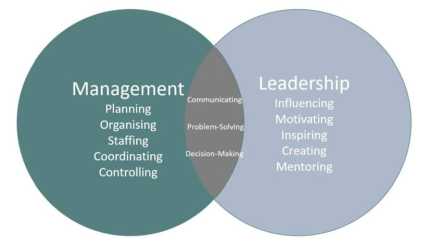
Source: (Billaud, 2021)
The starting point is the theory of traits, which is based on the fact that leaders are persons with special personality characteristics that enable them to perform their tasks and the job of a leader (Drucker P., 2006). So, a person possesses certain qualities that make him a leader, which enable him to do his job under expectations. It is these characteristics that separate leaders from their followers or persons of other professions (Drucker P., 1995).


Figure 2 and 3: Characteristics of a leader
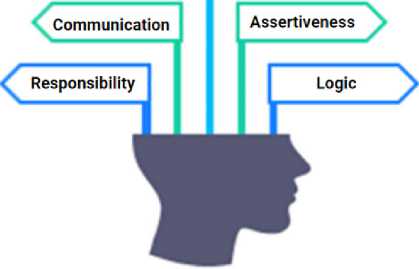

Source: adapted from (Drucker P. , 2006).
Here is an explanation of several important qualities that a leader should possess (Drucker P., 2006):
-
• Knowledge - the leader must know his job well as well as the work of his entire team and all followers, to be able to control, improve or modify it following the requirements of superiors or the needs of the company. Knowledge is one of the preconditions that leaders must govern (Bitel, 1997). It is expected that they must keep in mind how a certain job is done in its entirety, which means that they must know the entire team and the work process in the company that has to do with their business. This will make it easier for them to guide others, train them, and supervise them when necessary (Cohen & Bradford, 2005).
-
• Versatility - knowledge of different areas gives leaders the advantage to do business for several different reasons, ie to have a significant number of fields in which they can demonstrate their abilities. Versatility is reflected in the knowledge of many other techniques, topics, problems, business, and social spheres, and more (Warren, 2003). This characteristic is acquired during life, depending on how much and what the leader is interested in, what areas attract him, or what he needs for his business process and the role he has in the social and business world (Howard & Laskin, 1996).
-
• Ability to think logically - this characteristic is specific because it cannot be easily learned or practiced, but a large part of the participation of logic in the spectrum of other characteristics is innate (Rot, 2013). It is understood that the leader must connect the causes and consequences efficiently and intelligently, ie that a solution is reached that will logically be the most relevant for the new situation. Logic is sometimes even identified with intelligence, but this is a conceptual bypass although there are similarities (Chamy, 1996).
-
• Conceptuality - this trait is based on the fact that the leader must be able to follow the rules and procedures, as well as know the basic concepts used during his work, or the work of his followers (Grubić-Nešić, 2008).
-
• Responsibility - it is understood that a leader is a person who is not only responsible for his actions, but also the (business) activities of his followers, ie team members (Al Khajeh, 2018). This means that he is responsible for everything positive or negative that happens within his team. On the other hand, it means that he takes and bears the risk for negative outcomes, but that he does not take the only merits for the positive ones, but shares them with the rest of the team (Daft, 2014).
-
• Reference - the leader should be the person the team members will emulate, which means that he must serve as an adequate example to others. Accordingly, it is up to him to behave as his followers should behave in perspective (Bitel, 1997).
-
• Propensity to improve - training must be part of the characteristics and traits that the leader has. Namely, social changes are very fast and radical, thus changing technology, technique, human needs, and the like (Janićijević, 2008). All this requires changes in business and new requirements that are placed before companies. A leader is a person who needs to lead other people, motivate them and teach them in some way, and must be aware of all the changes. It follows from all this that the leader must constantly improve to keep up with the changes that are happening at the global level (Janićijević, 2008).
-
• Taking a risk - this characteristic is an indicator of the leader’s ability to take risks when others are not able to, ie to bear the risk of failure if the outcome of a business venture is not as expected (Janićijević N., 2013). There is a special area in management called risk management, which is the responsibility of trained managers and leaders. They believe that risk management is an inability to achieve some goals, that is, one must deviate from the expected results (Bass & Avolio, 1997).
-
• Familiarity with work standards - each company has certain work standards that a leader as a leader of a smaller or larger team must know. In this way, they will respect the policy of labor standards that the company is guided by, and will also have the task of transmitting these labor standards to their followers (Drucker P., 2006).
Behaviours of leaders
The behaviour of leaders can be explained and analyzed through the following set of theories that will be briefly discussed in this section - behavioural theories. The basic determinant that determines a leader according to these theories is his behaviour, hence the connection with behaviourism (Hirschmann, 2003). In this section, it is important to mention that these theories are divided into the following few (Drucker P., 2003):
-
• Use of authority;
-
• Ohio University Studies;
-
• University of Michigan Studies;
-
• Likert’s leadership model;
-
• Management network.
When it comes to the use of authority, leadership here is based on several basic styles with which the leader implements his decisions and manages his followers (Drucker P., 2003). Therefore, three basic types of leadership, i.e. style, are listed (Drucker P., 2006);
-
• Autocratic;
-
• Democratic; and
-
• Liberal.
Ohio and Michigan studies have certain similarities and are therefore often combined and grouped into a single study (Kouzes & Posner, 1997). These studies represent an analysis of how leaders behave when managing a particular organization, that is, a team. Thanks to the given studies, two basic dimensions can be recognized (Stodgill, 1963): initiating the structure and considering it. In this regard, the leader who is more inclined to initiate the structure is also in charge of the division of labour as well as tasks within his group, ie the success of the tasks performed. On the other hand, they are less inclined to human relations and the atmosphere that prevails within the group. This does not reduce their productivity, because they are very efficient; but will often encounter complaints from other team members (Lončarević, 2005). However, some leaders are more focused on interpersonal relationships within the group, and at the same time, followers will be closer to them and freer in communication or business relationships.
As for Likert’s model of leadership, his explanation is based on a combination of several leadership styles and variables. The following table provides a pictorial explanation that may approximate the meaning of this model.
Check for updates
Table 1 Likert’s model of leadership
|
^" ^... ^ style Variables ------------- |
Extremely autocratic |
Benevolently autocratic |
Consultative |
Participatory |
|
How much trust is placed in employees? |
Not at all |
Not much |
Much |
Complitely |
|
How much freedom do employees have to talk to leaders? |
Not at all |
Not much |
Pretty much |
Complitely |
|
How much freedom do employees have to give their ideas, that is, to implement them if they are valid? |
Rarely |
Sometimes |
Sometimes |
Always |
Source: adapted from (Drucker P. , 2006).
As can be concluded from the table, there are variables concerning the leader-employee relationship and the freedom they have within the work process, that is, the organization. In addition, these variables are closely related to leadership styles, which will also be discussed. The name is about how much freedom employees have to talk to their leaders or to express their ideas, so the outcome depends on how much leadership style a certain leader belongs to, or how much type of leader he uses (Drucker P.).
The managerial network, as the name suggests, is a network presentation of two variables: caring for people and caring for results (Northaus, 2008). So, it is a graph that shows that leaders can show more care for people, ie more care for results, which means that these two variables are in a mutually exclusive relationship. However, there is a possibility that leaders take both into account, but this means that one variable will have to suffer (Drucker P., 2006).
-
• Behaviour of persons of the same hierarchical level;
-
• Tasks and requirements;
-
• Characteristics and behaviours of followers, ie employees;
-
• Organizational culture and policy.
-
• Behaviour of persons of the same hierarchical level;
-
• Tasks and requirements;
-
• Characteristics and behaviour of followers, i.e. employees;
-
• Organizational culture and policy.
There are several well-known divisions of the situational approach (Stodgill, 1963):
-
• Fiedler model;
-
• House-Mitchel model;
-
• Stinson-Johnson model;
-
• Vroom-Yetton-Jago model;
-
• Hersey-Blanchard model.
Leadership Styles
-
• Autocratic;
-
• Democratic;
-
• Liberal (Laissez-faire);
-
• Transactional leadership style.
-
a) Autocratic leadership style
The autocratic type of leadership is, so to speak, the sharpest type according to which leaders have the opportunity to make important business decisions independently, and to only issue orders to their subordinates who carry them out (Yukl, 1998). In an organization with a general autocratic style of leadership, hierarchy is strictly respected and followers sometimes do not even have the opportunity to express their opinion, ideas, agreement, or disagreement with something. Leaders advance according to their qualifications, knowledge, and abilities so that they can delegate tasks to others according to their personality characteristics, specialization, and abilities (Whetten & Cameron, 2005).
Motivation in this style of leadership often involves sanctioning and punishing if the work is not done in accordance with the requirements, or if the expectations of superiors are not met (Milisavljevic, 1999). Leaders build their authority on the strict treatment of their followers without any democracy or freedom to participate in the decision-making process, on the contrary, employees are sometimes even completely excluded from the idea process. In return, they can be motivated in material terms, or simply in terms of avoiding sanctions and penalties (Mojić, 2000).
-
b) Democratic leadership style
This style is almost completely different from the one described above. Namely, the idea of a democratic style is to motivate employees to participate together in making some decisions and ideas (Bryman, 1986). The leader sometimes even has a friendly attitude towards his followers in order for them to be free to participate in the idea process and to be aware that they will not be punished for any idea or proposal. Of course, one should also keep in mind the personality characteristics of the followers, ie the knowledge that each employed worker may have a different leadership style (Petković, 2003). Consequently, the democratic style may not suit everyone. Essentially, the basic concept of a democratic style is that the entire relationship between leader and follower is based on democracy, not fear or hierarchy. Hierarchy relations are weaker here than in the style described above, and communication can take place at several different levels, as well as in several different directions (Schein, 2004).
When it comes to employee motivation and democratic leadership styles, it should be borne in mind that it is based mainly on different types of rewarding and stimulating followers as a sign of gratitude (Mojić, 2000). If employees do not meet the expectations of leaders, it does not mean that they will be punished, but they will be informed in which direction to continue their work process, ie how to improve their business. Punishment and sanctioning in any sense are non-existent in the democratic style of leadership (Gregor, 2003).
-
c) Laissez-faire leadership style
The liberal style of leadership, as it is otherwise called, is much freer compared to the previous two. What is interesting is that followers here are sometimes completely left to their own devices, which means that they have the opportunity to propose their ideas to the leader and organize their work process as they see fit (Cohen & Bradford, 2005). What is important is that the work is done, however, the leader here does not approach the disciplines of punishment or sanctioning in any way (Mojić, 2000). Employees can have different types of motivation, depending on their needs, preferences, and preferences. Leading such a group that belongs to the liberal style of leadership is quite flexible, and ad hoc and leaders adapt to the changing environment and the needs of the same (Kotter, 1999). Employees, in this case, do not know the fear of sanctions or penalties in any sense. Communication is enabled at all levels;
-
d) Transactional leadership style
One of the unusual styles, as this group of types is called, is transactional. He is often associated with the autocratic, due to the nature of the leader’s behaviour, but these are by no means synonymous. Namely, in this type of leadership, there is an overemphasis on the role and function of the leader in relation to the followers who in this relationship are understood as typically subordinate personalities (Ross & Offermann, 1997). So, in this relationship, there are clear demarcations as to who the leader is and what his responsibilities are; who is subordinate and what are his obligations. Only managers and leaders participate in decision-making and ideas, and employees are there to carry out their tasks. Motivation is not based on encouraging followers to think about ideas, but on executing them. When certain changes need to be implemented, this process is carefully considered because changes occur only when necessary. This style is not overly represented or popular because it does not meet the needs of companies in modern society. It is opposed to the transformational style of leadership, whose main feature is the tendency to frequent changes, which is reflected in the fact that leaders are constantly entering different situations to which they must get used, and which must adapt to their environment (Ross & Offermann, 1997).
Influence of leadership on the motivation of employees
The influence of leadership on employee motivation is closely related to the characteristics of the leader and the way he behaves towards his followers (Bass, 1988). Depending on the characteristics and style of leadership, the impact on motivation can be pronounced. A leader defines a wide range of traits, some of which have already been mentioned in the paper, but others must be listed to explain the achievement of motivation in employees. In addition, the motivation will be briefly defined to facilitate the understanding of the overall concept of the influence of leaders on employees.
Ability in a general sense can be defined as the ability to perform a certain behaviour or behaviour that results in a certain value. When a leader’s abilities are studied, he is defined through a certain set of abilities, and his work is evaluated in that context. However, what appears to be a problem with this notion - although it is “eternally current” - is the fact that there is no consistent set of human characteristics that will accurately distinguish between the common man and the leader. Different authors suggest different qualities and abilities of leaders as crucial for the process of successful leadership.
The abilities and skills of a leader largely determine the quality of his work and thus affect the quality of performance of subordinates (Al Khajeh, 2018). With that in mind, it is necessary to examine in detail what are the abilities and skills that determine successful leaders. The first question to be answered is the dilemma of whether there is a certain list of qualities and skills that will distinguish between successful and unsuccessful leaders. In other words, the question is whether it is possible to identify the specific characteristics of effective leaders and attribute to the success in the leadership process that an individual performs.
When examining leadership, different directions are pointed out, among which a difference is made depending on the type of variables that are observed and researched, ie that are considered relevant in determining the success of leaders. This is the difference between the characteristics of the leader, the characteristics of the followers, and the characteristics of the situation (Gehring, 2007). It can already be intuitively concluded that the leadership process is such that all these variables act simultaneously and determine the success of the leader, ie the leadership process itself. This approach is proposed within the integrative approach, however, other dominant approaches in studying leader performance are based on leader behaviour, power and influence of leaders, but there is also the so-called “situational approach to leadership”.
Figure 3 Maslow’s theory of Motivation
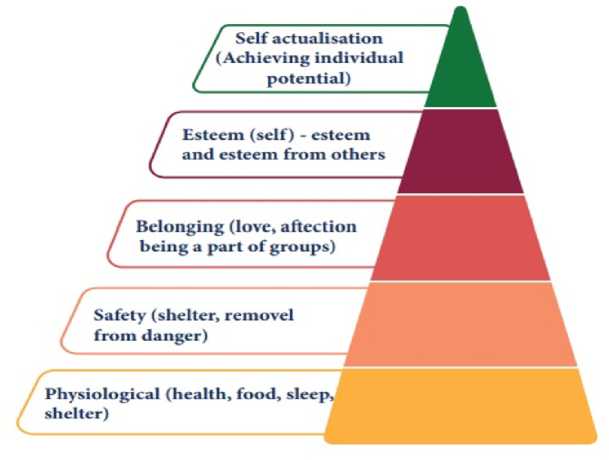
Source: (Brainkart, 25)
Another important theory we should mention is Herzberg’s theory that which is based on the existence of satisfaction factors and dissatisfaction factors. Quite unexpectedly, a person tends to avoid factors that create dissatisfaction, that is, to attract the latter.
Stogdil, Mann, Lord, and associates emphasize intelligence as one of the key traits of successful leaders. However, Kirkpatrick and Locke (1991) did not include intelligence as a crucial determinant of leadership success in their research but rather insisted on energy, motivation, integrity, reliability, cognitive ability, and task knowledge. Other traits that Stogdil identifies through his earlier research (1948) are alertness, insight, perseverance, self-confidence, and sociability. In his later research (1974), Stogdil abandons intelligence, alertness, and perseverance as the most important qualities of a leader, but adds perseverance, cooperation, and tolerance, so we see that a certain amount of flexibility is introduced into the profile of an effective leader. At the same time, Lord and associates consider intelligence, masculinity, and dominance to be essential qualities of effective leaders, so in their case, a kind of rigidity is still present and masculinity is insisted on as the main ingredient in determining the personality of an effective leader.
As this approach has been increasingly criticized as the focus has shifted from the belief that leaders are born to the claim that leaders are created or developed, there has been a need for a leadership approach based on leadership skills. Specifically, for skills, and thus for abilities, it is considered that they can be learned and that an individual adopts, develops, and applies them, but also transfers them to others and nurtures them with his associates, ie his followers.
As pointed out earlier in the paper, leaders are expected to lead and manage people in the organization. Leaders do this in order to transfer the understanding of the vision of the organization to their subordinates and make them work towards achieving it and align their activities with the goals of the organization. They recognize people’s talents, read their personalities, and try to motivate the members of the organization to make additional efforts and identify with the organization. In this regard, managing other people in the context of leadership refers to influencing people on a psychological level, rather than concrete management in terms of organizing activities, distribution of tasks, and similar activities that fall within the domain of the organization.
The idea that leaders rely on in practice, and authors in academic circles, is the claim that people are the greatest asset of an organization. Some of the authors who point to this are Bradley and McDonald. In line with this statement, it turns out that investing in people is of great importance for establishing wellbeing and good practice in the organization. This statement has been tested many times in practice and turns out to be true. In addition to the interests of the organization, this way directly affects the well-being of employees as individuals, so that in this sense, more goals are met. However, it is up to the leaders to recognize the importance of these investments and to recognize and manage the talents that need to be invested in. In this sense, it is necessary to point out that precisely because of the importance of the ability to manage other people, the concepts of leadership and management are often identified. As this has already been discussed in earlier parts of the paper, the differences between these two concepts will not be represented here.
Effective management of people in organizations is a phenomenon with several aspects, ie several ways of influence and with several levels, ie. impact on multiple levels. To better understand this process, we need more research to integrate human resource studies and leadership. The results of such research could reaffirm the credibility of the statement that people are indeed the greatest wealth of an organization.
Analysis and results
For this paper, managers of different levels, with different monthly incomes who lead teams of people between 5 and over 100 people were examined. The first part of the question refers to sociodemographic characteristics based on which further analyses and comparisons can be made later. The second part of the question refers to the connection between leadership and contemporary organizations, ways of leading a team, leadership styles, and other related elements related to leadership. The starting point for compiling this questionnaire is to test three established hypotheses.
Starting from the sex of the sample, 72.55% of respondents are female, while the rest - 27.45% of respondents are men.
Figure 4 Sex structure of the sample
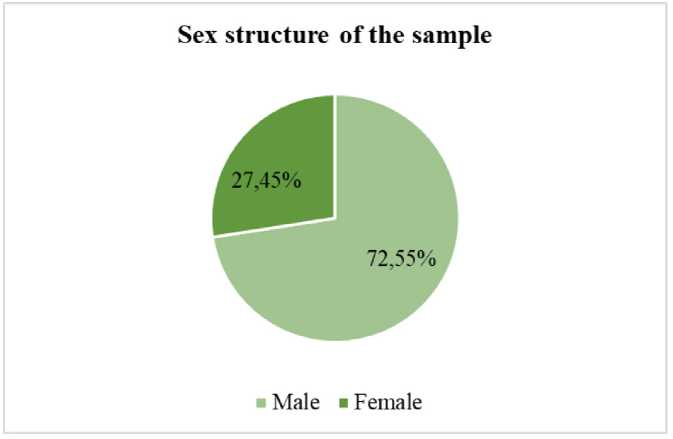
The age structure of the sample indicates age groups divided into three series of which 11.76% of respondents fell into the age group of 24-30 years, 40.20% belong to the group of 31-40 years, 26.47% of respondents have between 41-50 years old, while 21.57% of them are over 60 years old. The chart below is a graphical representation of the data provided.
Figure 5 Age structure of the sample
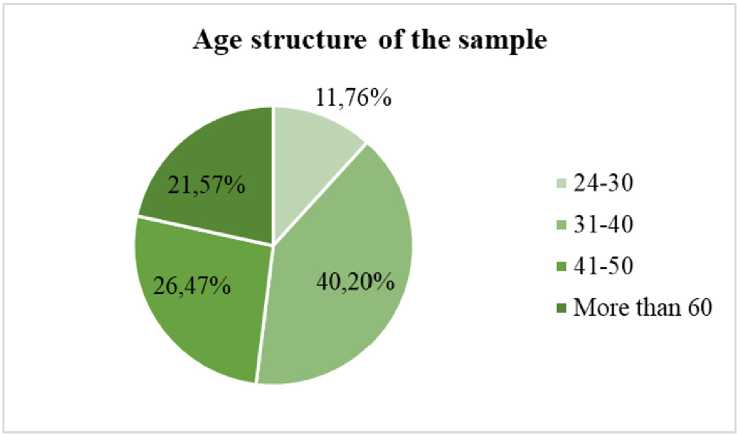
The age structure of the sample indicates age groups divided into three series of which 11.76% of respondents fell into the age group of 24-30 years, 40.20% belong to the group of 31-40 years, 26.47% of respondents have between 41-50 years old, while 21.57% of them are over 60 years old. The chart below is a graphical representation of the data provided.
Figure 5 Age structure of the sample
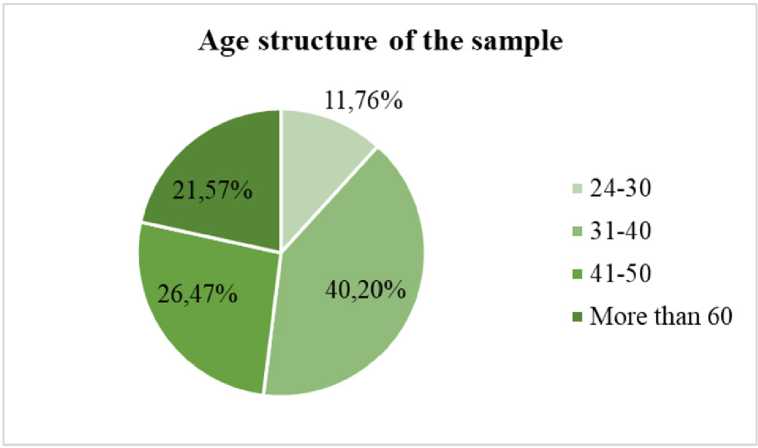
When it comes to education level, the distribution of respondents was done according to completed high school, bachelor studies, master’s studies, and PhD studies. Of the total number of respondents, the largest number of them completed master’s studies, almost 60%, followed by leaders who completed bachelor studies 24.51%, followed by 8.82% who completed high school, and only 6.86% of respondents PhD studies.
Table 2 Education level structure
|
Education level structure |
|
|
High school |
8.82% |
|
Bachelor studies |
24.51 |
|
Master studies |
59.80 |
|
PhD studies |
6.86% |
|
Total |
100.00% |
When it comes to the classification of respondents according to age and style to which they belong, the following data obtained in this research can be seen in the figures below.
Table 3 The structure of respondents according to age and leadership style to which they belong
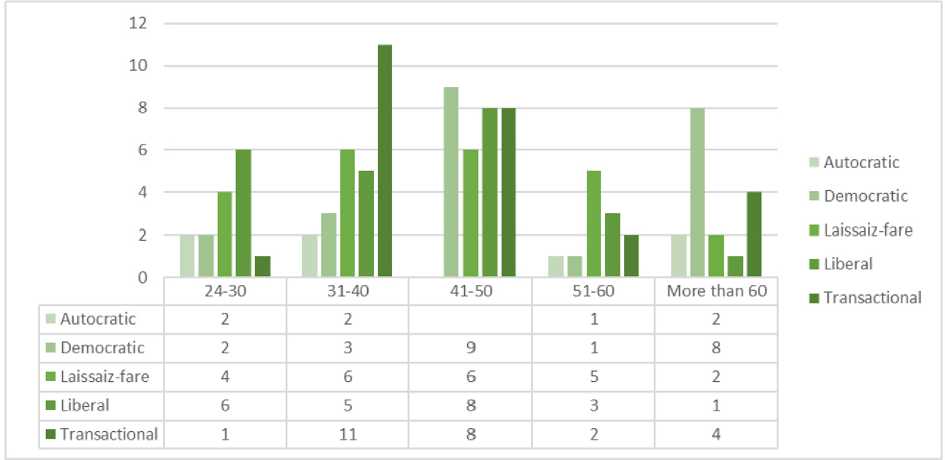
Important information for the research is also how much time the leaders spent in current positions. In this regard, the following figures are attached.
Figure 6 The structure of the respondents’ according to the time they have been working in the current position
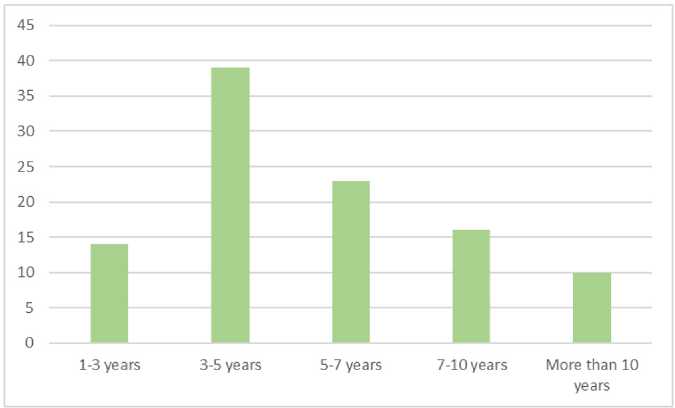
According to the answers of the respondents, to conclude that the largest number of respondents belongs to the group of 3-5 years, then the leaders spent the most between 5 and 7 years in a given leadership position, the next group belongs to the range of 7 to 10, while the penultimate place is leaders who have spent between one and three years in their positions and slightly fewer leaders who have held the same position for over 10 years.
It is very important to examine how leaders motivate their employees in order to achieve the expected success, more precisely which methods they use to encourage them to perform tasks and achieve common goals. In this regard, the upcoming figures indicate ways of motivation through which leaders encourage their team members to work.
Figure 7 The structure of the respondents according to the way they motivate team members
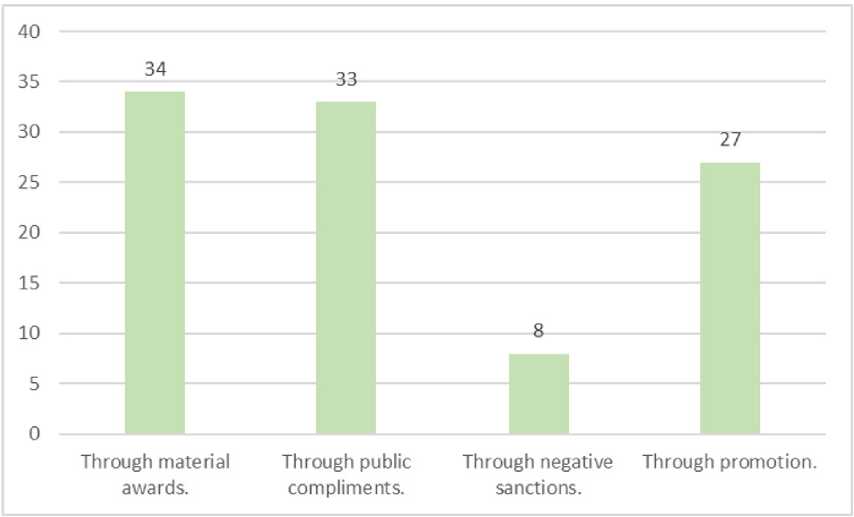
According to Figure 7, it can be concluded that most leaders motivate their team members through material awards and public compliments, as well as through promotion, while only 8 leaders do so through negative sanctions.
In addition to motivation, there are cases when the leader will have to sanction his followers for various reasons. In this regard, there was interest in further study of these possibilities, and the questionnaire included that question. Namely, the following figures indicate the following answers and possibilities.
Figure 8 The structure of respondents according to the way they sanction team members
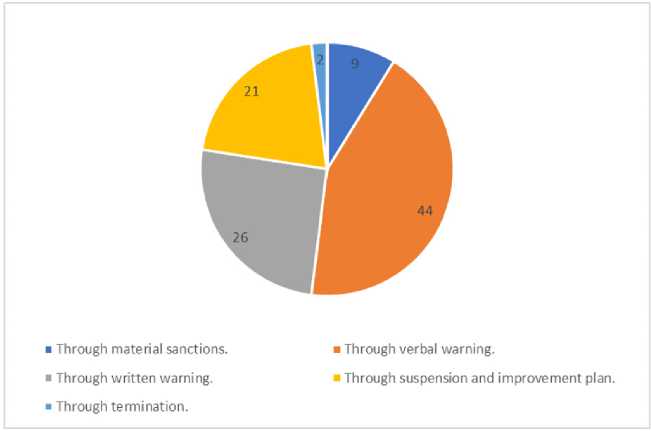
As might be expected, most respondents choose the means of sanctioning through verbal warning or in writing. There is a possibility of suspension or improvement of the plan exercised by 21 respondents. Then, 9 respondents use material sanctions, while only 2 respondents sanction their team members through termination.
Analysis of hypothesis
The first hypothesis in this paper says the following: There is a statistically significant correlation between effective leadership style in the company and the efficiency of the employees. Therefore, the null hypothesis here is:
H0: There is no statistically significant correlation between effective leadership style in the company and the efficiency of the employees.
It is tested against H1: There is a statistically significant correlation between effective leadership style in the company and the efficiency of the employees.
Table 4: Leadership style of the leader and efficiency of the team
|
10. As for your opinion, to which leadership style do you belong to? |
20. How would you rate the efficiency of your team? |
|||||
|
1 |
2 |
3 |
4 |
5 TOTAL |
||
|
Autocratic |
2 |
1 |
1 |
1 |
1 |
6 |
|
Democratic |
3 |
4 |
5 |
9 |
8 |
29 |
|
Liberal |
0 |
7 |
6 |
6 |
4 |
23 |
|
Laissaiz-fare |
2 |
2 |
3 |
3 |
2 |
12 |
|
Transactional |
1 |
0 |
10 |
15 |
6 |
32 |
|
TOTAL |
8 |
14 |
25 |
34 |
21 |
|
To test this hypothesis, a Chi-squared test will be conducted. The degree of freedom for this purpose is 16. The significance level, α is set at 0.1. The realized value is calculated at 23.59, while the critical value is 23.54. Therefore, the null hypothesis is discarded, and H1 is confirmed (Figure 9).
Figure 9
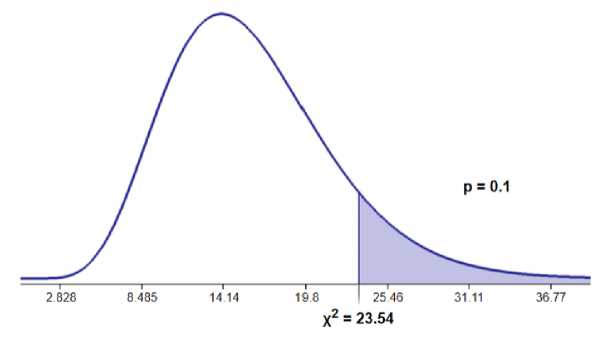
It can be stated that there is a statistically significant correlation between effective leadership style in the company and the efficiency of the employees. Also, to better understand how different leaders rate their team efficiency, it is useful to take a look at the structure of their answers.
Namely, one-third of the autocratic leaders marked their team efficiency with 1, which implies a very low level of efficiency. On the other hand, more than 30% of the democratic leaders stated that their team efficiency is at level 4. Moreover, almost 47% of the transactional leaders said their team reached the same level of efficiency – level 4, while there are almost no transactional leaders who marked their team efficiency with grades 1 or 2.
Figure 10 The structure of the respondents according to the efficiency score style of the leader

On the other hand, when analyzing leadership styles and efficiency at the company level, the results do not differ a lot. Namely, half the autocratic leaders totally disagree or do not agree that there is a high degree of efficiency in the company they work in, while more than one-third of transactional leaders agree with the same statement.
The second hypothesis in this paper says that there is a statistically significant correlation between the process of changing leadership styles in an organization and the increasing motivation of its employees. Therefore, the null hypothesis here is:
H0: There is no statistically significant correlation between the process of changing leadership styles in an organization and the increasing motivation of its employees.
and it is tested against H1: There is a statistically significant correlation between the process of changing leadership styles in an organization with the increasing motivation of its employees.
In total, 27 leaders stated that they have changed their leadership style, which is more than onefifth of the questioned sample. However, in this case, a problem arises: not all the leaders who have changed their leadership style did that knowingly. Consequently, almost 50% of the asked leaders are unsure whether they have ever changed their leadership style. This gap leaves a lot of space for different conclusions that could be reached if there was a better education of the leaders about the differences between styles in managing people. Also, it is worth noticing that 21 leaders stated they have never changed their leadership style.
To analyze the structure of the answers a contingency table (table 5) has been created using the Pivot table tool in Excel, and the graph according to the table is shown.
Table 5: Contigency table, changes in the leadership style and current leadership style
|
Count of Have you ever changed your leadership style? Column Labels^B |
Liberal Transactional Grand Total |
|||||
|
Row Labels |
’Autocratic |
Democratic |
Laissaiz-fare |
|||
|
Maybe, 1 am not sure. |
2 |
8 |
12 |
9 |
17 |
48 |
|
No, 1 have not. |
3 |
13 |
7 |
8 |
7 |
38 |
|
Yes, 1 have. |
2 |
2 |
4 |
6 |
2 |
16 |
|
Grand Total |
7 |
23 |
23 |
23 |
26 |
102 |
As seen in the table, most autocratic leaders were not flexible and have never changed their leadership style, as well as democratic leaders. Laissaiz-faire-oriented leaders were often unsure whether they have changed their leadership style, but also 35% of them stated they have not changed their leadership style. Liberal leaders were also unsure in 40% of the cases and responded negatively in 35% of the cases. The majority of the transactional leaders said they have maybe changed their leadership style, and only 8% of them were confident they have changed it. Overall, most of the respondents who said they have changed their leadership style fall in the category of liberal leaders, and the greatest number of responses “No, I have not” came from the transactional leaders.
Figure 11 The structure of the respondents according to the changing the leadership style
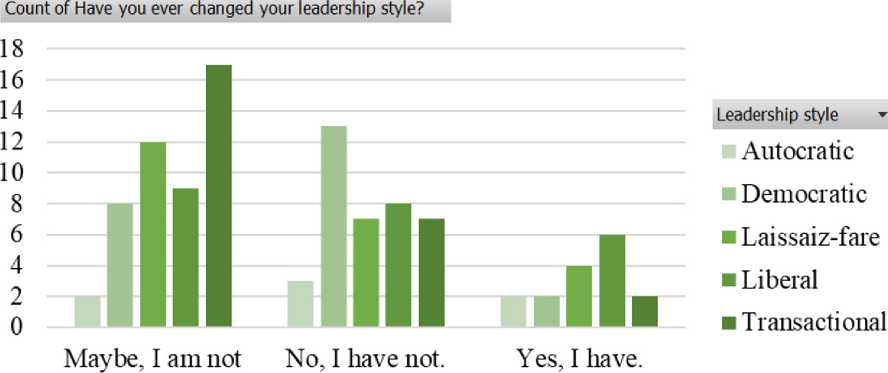
sine
Have you ever changed your leadership style? ’
However, out of 27 people who are sure they have changed their leadership style, 70% stated that it has affected their team members’ motivation to work positively, i.e. it has increased their motivation to work. Only 2 of them noticed the motivation to work decreased after they have changed their leadership style, while 6 stated it had not had any effect on the team members’ motivation to work.
Figure 12 The structure of the respondents according to the question if they had changed their leadership style, how did that affect their team members motivation to work
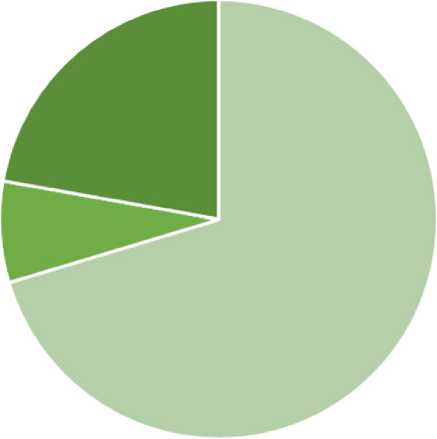
It increased their motivation to work,
-
■ It decreased their motivation to work.
-
■ It did not affect their motivation to work.
26. If 1 changed my leadership style, the motivation of my team members would probably increase.
Number of responds
Totally disagree
19
1 do not agree
22
Neither agree nor disagree
34
1 agree
18
Totally agree
9
TOTAL
102
From the graph above it is clear that most leaders have seen improvement in their team members’ motivation to work after they have changed their leadership style. These results lead to the conclusion that there is a correlation between the process of changing leadership styles in an organization with the increasing motivation of its employees.
Finally, it was questioned whether the leaders thought their team members’ motivation to work was likely to increase as a consequence of a change in leadership style. In this case, most of the respondents neither agreed nor disagreed (one-third), while less than 10% were certain the change in their leadership style would benefit the team’s motivation to work. Around 40% of the leaders from the sample totally disagreed or did not agree with the given statement, and only slightly more than one-fifth of them agreed or totally agreed with the same statement, as can be seen in the table below.
Table 6 The structure of the respondents according to the attitude if they had changed their leadership style, how did that affect their team members’ motivation to work
However, it was important to show which category of the leaders according to their leadership style was most likely to totally disagree, and which was more prone to agree with the positive effects of changing the style. The results are given in the graph below.
Figure 13 The structure of the respondents according to the question if they had changed their leadership style, how would that affect their team members’ motivation to work
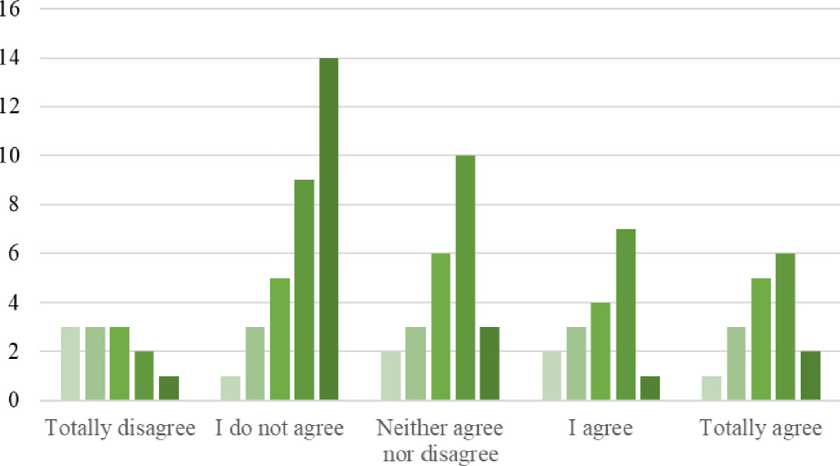
Autocratic ■ Democratic «Liberal ■ Laissaiz-faiie ■Transactional
Autocratic leaders presented almost uniform answers, although the biggest number totally disagreed. Democratic leaders have answered uniformly, as well, as there were three answers from this group of leaders for each statement, which does not allow for making a precise conclusion. Liberal leaders were not extreme, too since most of them said they neither agree nor disagree. Leaders who follow a laissaiz-faire leadership style usually neither agree nor disagree, but more of them do not agree compared to the number of those who agree, which can lead to the conclusion that they usually are not in favor of the change. Finally, transactional leaders by far do not agree with the statement and strongly defend their leadership style.
Finally, the third hypothesis refers to the correlation between leadership style and achievements of employees:
H0: There is no strong correlation between leadership style and achievements of employees.
is tested against H1: There is a strong correlation between leadership style and achievements of employees.
In order to test this hypothesis, a Chi-square test will be conducted. The degree of freedom for this purpose is 12. The significance level, α is set at 0.1. Realized value is calculated at 31.731, while the critical value is 18.549. Therefore, the null hypothesis is confirmed, and it can be stated that there is no strong correlation between leadership style and the achievements of employees (Figure 14).
Figure 14
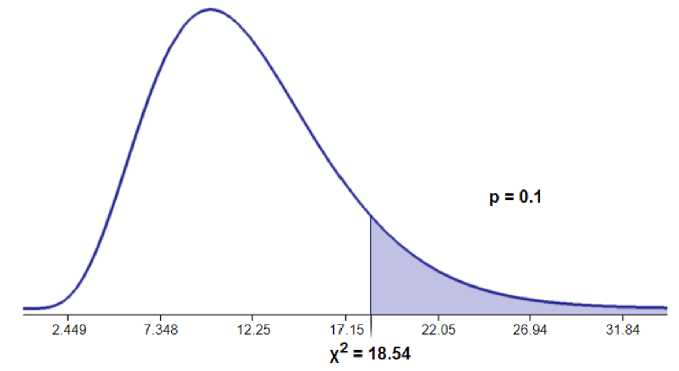
Table 7 The structure of respondents’ responses according to belonging to a certain leadership style and expectations about the success of team members
|
10. As for your opinion, to which leadership style do you belong to? |
23. As for your opinion, do yourteam members succeed according to your expectations? |
|||||
|
Yes, they always do. |
They usually do. |
They usually do not. |
No, they never do. |
TOTAL |
||
|
Autocratic |
0 |
0 |
2 |
4 |
6 |
|
|
Democratic |
10 |
12 |
4 |
3 |
29 |
|
|
Liberal |
6 |
11 |
4 |
2 |
23 |
|
|
Laissaiz-fare |
4 |
2 |
3 |
3 |
12 |
|
|
Transactional |
3 |
5 |
14 |
10 |
32 |
|
|
TOTAL |
23 |
30 |
27 |
22 |
102 |
|
Discussion
When it comes to the link between leadership style and employment efficiency, it was pointed out that autocratic leaders generally have too high expectations of their team members, and that employees usually or never meet those expectations. Autocratic leaders generally believe that employees can always achieve more (Cherry, 2015), and this fact should not be surprising.
The quality of the relationship between the leader and the employee can be built in different ways, and the way of motivating, sanctioning, or creating a strong bond between team members is represented by some of them (Adizes, 1979). In the given research, the data indicate that as many as 34 out of a total of 102 leaders materially reward their team members for excellent success, while only 2 leaders sanction team members through termination.
Research can be used for further purposes to gain deeper and more detailed knowledge of leadership. As this is an inexhaustible topic, it is important to constantly improve and connect it with related studies. The results of this research can be used in the field of leadership, leadership styles in modern organizations, and how to motivate employees and resolve conflicts between conflicting parties. The contribution of this research is seen not only in leadership theory but also in practice that can be used by various companies that can further educate their leaders.
Conclusion
The idea of this paper was based on studying the effects of different models of leadership in modern organizations. Needless to say, the importance of leadership in the study of modern organizations is primarily reflected in the justification of this research. Namely, the relevance of the topic is reflected in the fact that this topic is always relevant and necessary for study, bearing in mind that social circumstances, and thus the direct and immediate environment of companies are constantly changing.
The method used to survey the leaders is through a questionnaire, and the research process itself is supported by primary and secondary data. Secondary data refer to the first part of the paper, which included theoretical concepts and reliance on other studies whose subject of interest was similar or the same. The primary data included research to test the hypotheses.
102 leaders in various positions participated in the work, of which more than 72% were women, while slightly less than 28% were male leaders. The largest percentage of leaders completed master’s and bachelor’s studies, while a small percentage of them completed high school or PhD. For the most part, some leaders are perceived as democratic, liberal, or transactional. When it comes to established hypotheses, the first hypothesis that indicates a statistically significant correlation between effective leadership style in the company and the efficiency of employees has been confirmed or it has been established that the mentioned correlation exists. The second hypothesis regarding the statistically significant correlation between the process of changing leadership styles in an organization and with increasing motivation of its employees has also been confirmed. The third hypothesis, which implied a strong correlation between leadership style and the achievements of employees, is disputed, which can be verified in the previously mentioned conclusions regarding it. The results of the research can be a support for other scientists who want to further analyse leadership, organizations, leadership styles, and other elements in contemporary organizations. The future of leadership is certainly reflected in the changes that are yet to come, which will encourage existing leaders in their positions to adapt and eventually adjust their way of leading team members or companies.
Список литературы The effects of different models of leadership in contemporary organizations
- Abraham, Z. (1977). Managers and Leaders. London: Harvard Business Review.
- Adizes, I. (1979). Dijagnoza stilova upravljanja. Novi Sad: Prometej.
- Al Khajeh, E. H. (2018). Impact of leadership styles on organizational performance. Journal of Human Resources Management Research, 1-10.
- Al Khajeh, E. H. (2018). Impact of leadership styles on organizational performance. Journal of Human Resources Management Research, 1-10.
- Bass, B. (1988). The inspirational processes of leadership. Journal of Management Development.
- Bass, B., & Avolio, B. (1997). Full range leadership development: manual for the Multifactor Leadership Questionnaire. Palo Alto: Mindgarden.
- Behfar, K. J., Peterson, R. S., Mannix, E. A., & Trochim, W. M. (2008). The critical role of conflict resolution in teams: a close look at the links between conflict type, conflict management strategies, and team outcomes. Journal of applied psychology, 93(1), 170.
- Billaud, A. (2021, September 20). What Is The Difference Between A Leader And A Manager? Retrieved from https://www.themilestoneacademy.com: https://www.themilestoneacademy.com/blog/what-is-the-difference-between-a-leader-and-a-manager
- Bitel, L. (1997). Liderstvo. Beograd: Clio.
- Brainkart. (25, April 2022). Maslow’s theory of Motivation. Retrieved from https://www.brainkart.com: https://www.brainkart.com/article/Maslow-s-theory-of-Motivation_37800/
- Bryman, A. (1986). Leadership and Organizations. London: Routledge&Kegan Paul.
- Carstens, F. J., & Barnes, N. (2006). The quality of leader/employee relationship in business performance. SA Journal of Human Resource Management, 4(2), 10-19.
- Chamy, C. (1996). Efikasan menadžer. Beograd: Grmeč.
- Cherry, K. (2015). Leadership styles. Wiley encyclopedia of management, 1-2.
- Cohen, A., & Bradford, D. (2005). Influence without Authority. New York : John Wiley & Sons.
- Daft, R. L. (2014). The leadership experience. Stamford: Paperback .
- Došenović, D., Mustafić, A., & Lukić, Z. (2015). Menadžment i Liderstvo/Management and Leadership. Economics, 3(1), 67-78.
- Drucker, P. (1995). Menadžment za budućnost. Beograd: Privredni pregled.
- Drucker, P. (2003). Мој погледа на менаџмент. Адиџес: Нови Сад.
- Drucker, P. (2006). The Practice of Management. New York: Harper Business.
- Gardner, J. (1993). On leadership. New York: Simon and Schuster.
- Gehring, D. R. (2007). Applying traits theory of leadership to project management. Project Management Journal, 38(1), 44-54.
- Gregor, M. (2003). The human size of enterprise. New York: Annual Editions.
- Grubić-Nešić, L. (2008). Znati biti lider. Novi Sad: AB Print.
- Hirschmann, K. (2003). Leadership. Portsmouth: Heinemann Library.
- Howard, G., & Laskin , E. (1996). Leading minds. USA: Basic Books.
- Janićijević, N. (2008). Organizaciono ponašanje. Beograd: Data status.
- Janićijević, N. (2013). The mutual impact of organizational culture and structure. Economic annals, 58(198), 35-60.
- Košičiarová, I., Kádeková, Z., & Štarchoň, P. (2021). Leadership and motivation as important aspects of the international company’s corporate culture. Sustainability, 13(7), 3916.
- Kotler, P., Kartajaya, H., & Setiawan, I. (2017). Marketing 4.0: Moving from Traditional to Digital. Hoboken: John Wiley & Sons, Inc.
- Kotter, J. (1999). What Leaders Really Do. London: Harward Business Review.
- Kouzes , J., & Posner, B. (1997). The leadersip challenge. San Francisko: Jossey-Bass.
- Leroy, H., Segers, J., van Dierendonck, D., & den Hartog, D. (2018). Managing people in organizations: Integrating the study of HRM and leadership. Human Resource Management Review, 28(3), 249–257.
- Lievens, F. (2015). Human resource management. Leuven: Lannoo Campus.
- Mojić, D. (2000). Theories of Oganizational Leadership. Sociologija , 349-376.
- Nadler, D. A., & Tushman, L. M. (1990). Beyond the charismatic leader: Leadership and organizational change. California management review, 32(2), 77-97.
- Navy, S. L. (2020). Theory of human motivation—Abraham Maslow. Science Education in Theory and Prac-tice, 17-28.
- Northaus, P. (2008). Liderstvo, teorija i praksa. Beograd: Data Status.
- Northouse, P. G. (2015). Leadership: Theory and Practice. . Sage publications.
- Petković, M. (2003). Organizaciono ponašanje sa menadžmentom ljudskih resursa. Beograd: Centar za izda-vačku delatnost Ekonomskog fakulteta.
- Robbins, S. (2001). Organizational Behaviour. London: Prentice-Hall International.
- Robert, K., & Kinicki , A. (1999). Organizational Behaviour. Berkshre: McGraw-Hill.
- Ross, S., & Offermann, L. (1997). Transformational leaders: measurement of personality attributes and work group performance. Personality and Social Psychology Bulletin, Vol. 23, 1078-1087.
- Rot, N. (2013). Opšta psihologija. Beograd: Zavod za udžbenike.
- Schein , E. H. (2004). Organizational culture and leadership, Third edition. San Francisco: Jossey Bass.
- Spoor, J. R., & Kelly, J. R. (2004). The evolutionary significance of affect in groups: Communication and group bonding. Communication and group bonding. Group processes & intergroup relations, 7(4), 398-412.
- Stodgill, R. (1963). Manual for the Leader Behavior Description. Questionnarre from XII, Columbus: Ohio State University of Business Research, 9-11.
- Stoner, J. A., Friman, R. E., & Gilbert, D. R. (1997). Mенаџмент. Београд: Желнид.
- Warren , B. (2003). On becoming a leader: The leadership classic - Updated and Expanded. USA: Perseus Publishing.
- Whetten, D. A., & Cameron, K. S. (2005). Developing Management Skills. New York: Prentice Hall.
- Wright, C., Atkins, S., & Jones, B. (2012). An analysis of elite coaches’ engagement with performance analy-sis services (match, notational analysis and technique analysis). International Journal of Performance Analysis in Sport 12, 436-451.
- Yukl, G. (1998). Leadership in Organizations. New York: Prentice Hall.
- Yukl, G. (2012). Leadership: What is it. Leadership 3rd ed., 1–42.
- Јанићијевић, Н. (2011). Утицај организационе културе на лидерство у организацији. Београд: ЦИД.
- Лончаревић, Р. (2005). Менаџмент у акцији: комуницирање, мотивисање, управљање групама. Бања Лука: Економски факултет.
- Милисављевић, М. (1999). Лидерство у предузећима. Београд: Чигоја.
- Мојић, Д. (2002). Новији приступи проучавању вођства у организацијама. Београд: Филозофски факултет.
- Тодоровић, Ј., Ђуричин , Д., & Јаношевић, С. (1998). Стратегијски менаџмент. Институт за тржишна истраживања, 320-323.

